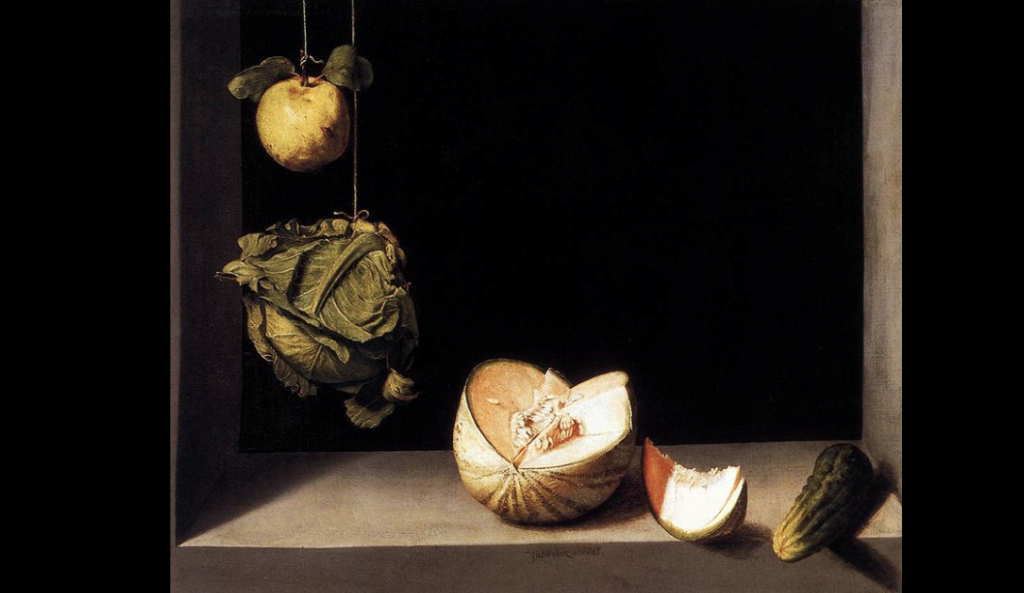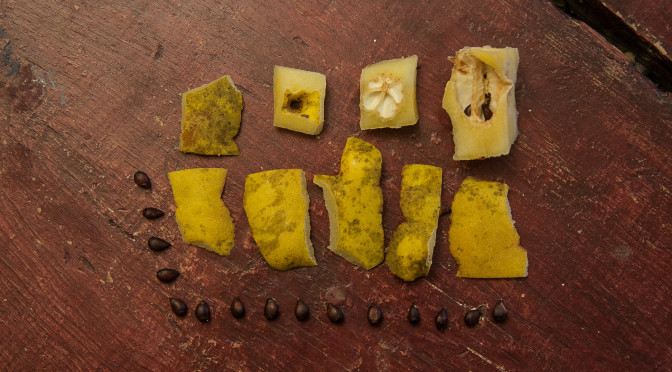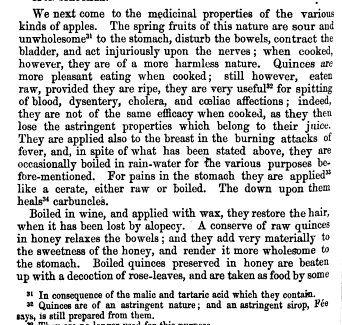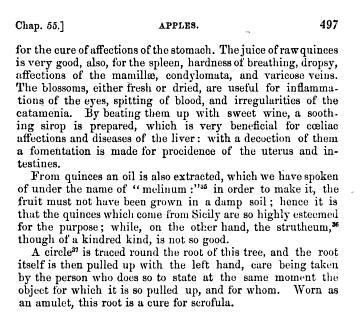I stand in my robe in the front yard at 7:15am staring at my newly-installed siding, admiring, critiquing, dreaming of spring plantings. The sky is a grim, Vancouver-grey, and every deciduous thing is naked and brown. We inhabit the season of ugliness which refuses to yield to the energetic vibrancy of indigo and goldenrod, my house colours. I don’t bother to snap photos of my work, because even Old Gal is unphotogenic today.
I assume that the flash of gold I catch in the corner of my eye is a leaf that has refused to conform to the season. But it is not a leaf. On the ground, tucked under a common barberry, lay a single yellow ovoid something, smooth-skinned and slightly dappled, potato-hard with no sign of bruising, the rough size of a kiwi (if it were leaner), but with a more agreeable texture. I roll it between my palms and exfoliate the dirt with my thumbs, raise it to my nose, and inhale: mandarin, a side of fecund earth, a note of honey. It is definitely some kind of fruit.
I rush inside to share my treasure (like I used to do with our peaches), to dissect it with a paring knife and pass slivers to the children who are leaving for school. Three declare it sour, the fourth makes The Face and spits it into the compost bin. Contrary to his expression, it is not disgusting, but it is tart, stringent like rhubarb with an equally potent flavour. Like rhubarb, it clearly requires a side of sugar.
I remember that half-hidden beneath that prickly barberry grows another shrubby beast, studded with wicked thorns, barren for as long as it has been planted, overshadowed, forgotten: a quince.
The Quince (Pyrus Cydonia) has been under cultivation since very remote times. It is a native of Persia and Anatolia and perhaps also of Greece and the Crimea, though it is doubtful if in the latter localities the plant is not a relic of former cultivation. It is certain that the ancient Greeks knew a common variety, upon which they grafted scions of a better variety, which they obtained from Cydon in Crete, from which place the fruit derived its name of cydonia, of which the English name Quince is a corruption. ((((https://www.botanical.com/botanical/mgmh/q/quince04.html))
References to Quince, thought to be the ‘golden apples,’ are found throughout classic art and literature:
By the Greeks and Romans, the Quince was held sacred to Venus, who is often depicted with a Quince in her right hand, the gift she received from Paris.
The fruit, being dedicated to Venus, was regarded as the symbol of Love and Happiness, and Plutarch mentions the bridal custom of a Quince being shared by a married pair. Quinces sent as presents, or shared, were tokens of love.
It was very widely cultivated in the East and especially in Palestine, and many commentators consider that the Tappuach of Scripture, always translated Apple, was the Quince. It is also supposed to be the fruit alluded to in the Canticles, ‘I sat down under his shadow with great delight and his fruit was sweet to my taste’; and in Proverbs, ‘A word fitly spoken is like Apples of gold in pictures of silver.’ ((https://www.botanical.com/botanical/mgmh/q/quince04.html))
Arguably, it was a quince, and not an apple, that led to mankind’s biblical downfall.


In his Natural History, Volume 4 written circa AD77, Pliny the Elder writes of its various medicinal uses including the restoration of hair lost to alopecia, a variety of stomach upsets, diseases of the liver, inflammation of the eyes and as an amulet the ward off scrofula (tuberculosis). He notes that “Quinces are more pleasant eating when cooked.”
Since amulets have fallen out of fashion, the quince has, in the west, been relegated to the jelly jar.
I cube the remaining fruit, add water, sugar, honey, vanilla bean and pop it into the microwave, covered. It explodes (literally) filling the house with an intoxicating fragrance. I recover a few tablespoons which I share with my neighbour, a gardener, who passes by with her dog. The quince sauce tastes like it smells: piquant, rich, the opposite of bland. We lose ourselves in a chorus of shivery “Mmmmmm’s,” a perfect antidote to the oppressive grey, and she carries away a slip of pips to plant her own golden goodness.
Additional information/recipes:
Lee Reich’s Uncommon Fruits for Every Garden
Nigel Slater’s Quintessential Quince



2 responses to “Unexpected Things You Find in Your Garden”
Oh, lovely! Quince jelly is the jewel of late fall, I think. I once found a bounty under a stunted tree in the Nicola Valley and made jam. Perfect on warm croissants. F & M poached some last fall to have with ice-cream. Maybe time to plant a tree…
Wonder where they found them in Ottawa? Farmer’s market? A middle eastern specialty store? I’m going hunting so I can make a larger batch…..